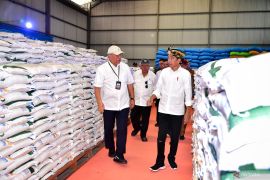In March 2023, the government launched its rice assistance program targeting 21.6 million beneficiary families as part of efforts to check an increase in rice prices. Under the assistance program, each beneficiary family is receiving 10 kilograms of rice per month.
In addition, the government has also launched the Food Stock and Price Stability (SPHP) program targeting the lower middle class, under which rice of medium quality is being sold at lower prices. The rice is being distributed by the State Logistics Agency (Bulog).
The SPHP rice is being sold in traditional markets, modern retail stores, and outlets of Bulog and regional governments at Rp10,900 (US$0.69) per kilogram in zone 1, Rp11,500 (US$0.73) per kilogram in zone 2, and Rp11,800 (US$0.75) in zone 3.
This year, the problem of high rice prices has not abated. According to Statistics Indonesia (BPS), in January, 28 provinces in Java, Bali, and Nusa Tenggara recorded an uptick in rice prices.
Rice experienced an inflation of 0.64 percent in January 2024, contributing 0.03 percent to the main inflation.
Food commodities, including rice, sugar, meat, and eggs, are categorized as commodities with volatile prices.
The government has been making efforts to curb rice prices and inflation, including by extending the provision of rice assistance.
The rice assistance program is utilizing the government rice reserves (CBP) in line with the mandate of Government Regulation Number 125 of 2022 on the Management of Government Rice Reserves.
Head of the National Food Agency (Bapanas) Arief Prasetyo Adi said on January 22, 2024, that more than 89 million low-income people have so far benefited from the monthly distribution of rice assistance by the government.
According to Adi, the rice assistance distribution will likely be continued until June and will target 22 million beneficiary families.
The figure is around 8 percent higher compared to 2023, adjusted to the Targeting for the Acceleration of Extreme Poverty Elimination (P3KE) data managed by the Coordinating Ministry for Human Development and Culture.
The total number of beneficiary families is 22,004,077 consisting of 6,878,649 decile 1 families, 7,474,796 decile 2 families, and 7,650,632 decile 3 families.
Government efforts to respond to the increase in staple goods prices have not only involved food assistance distribution, but have also included the provision of social assistance, such as cash assistance to increase people's purchasing power and to help them meet their daily needs.
Cash assistance of Rp200 thousand (around US$12.71) per month is being doled out for the first three months of 2024 to mitigate food-related risks. The assistance is targeted at 18.8 million beneficiary families.
The cash assistance is expected to serve as a cushion for poor people so that they do not lose their purchasing power amid the increase in food prices because more than 60 percent spending of the poor is on food.
Still, the provision of food and social assistance is not the main way to create price and inflation stability. A researcher from the Center of Reform on Economics (CORE) Indonesia, Eliza Mardian, stated that the government must also control inflation by ensuring sufficient food supply as well as safe distribution.
In addition, breakthroughs and new policies are also deemed essential long-term solutions for handling structural poverty. This is aimed at supporting low-income people so that they do not rely on government assistance forever.
Food diversification
For this year, the Ministry of Finance has increased the social protection budget to Rp493.5 trillion (around US$31.35 billion). The budget has been allocated to maintain people's purchasing power amid food price volatility.
The Ministry of Finance has also set aside a budget of Rp114.3 trillion (around US$7.26 billion) for 2024 to control national food prices.
Despite the special budgets to protect the community, it is still necessary for the government to carry out other efforts, one of which is food diversification.
Program director at the Institute for Development of Economics and Finance (Indef), Esther Sri Astuti, said that the food diversification strategy is one of the keys to handling the surge in rice prices.
"The concrete suggestion to reduce economic pressure due to an increase in rice prices, I think we do not have to eat rice, there are many sources of carbohydrates, not only rice, it can be cassava and sorghum. Therefore, the concrete suggestion is food diversification," Astuti explained.
According to her, food diversification has the potential to create food supply stability and ease inflation risks that could emerge tracking the increase in rice prices.
"Thus, there should be a food diversification so that when there is an increase in rice prices, we can be more calm," she said.
Indonesia is rich in various types of plants that can be used as staples.
Thus, the government can boost its campaign to promote other carbohydrate sources such as corn, cassava, sorghum, sweet potato, and sago.
Related news: Bapanas optimizing use of millets as alternative food source
Related news: Home minister promotes food diversification to cut reliance on rice
Editor: Rahmad Nasution
Copyright © ANTARA 2024












